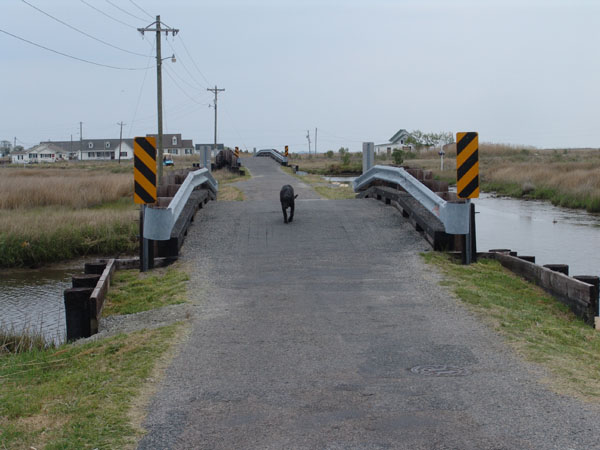|
LEAVING ATLANTIC YACHT BASIN AND HEADING FOR
CAPE CHARLES
Weíre up early and ready to start our first day out. We plan to start engines at 7:30 AM and pull away from AYB docks at 7:45 AM and get in position for Great Bridgeís 8:00 AM opening. We say our last goodbyes, and head on up the last stretch of the Intracoastal Waterway, heading out into the Chesapeake. Our destination today, is Cape Charles on the Eastern shore of Virginia at the mouth of the Chesapeake. We are anxious to see this port as it was a busy place for shipping until the Chesapeake Bay Bridge Tunnel was built in the 50ís and changed the course of this old shipping town. Itís supposed to be a town set in time with more historical homes in place than any other town on the East Coast. We head through Great Bridge and into Great Bridge Locks which will officially dump us back into salt water again. The water still is black and brackish as we were visibly reminded by the ďdirty mustachesĒ that many boats had from traveling up the ICW. Not having been on the boat for 8 months, we were a little rusty. We already slipped up briefly at the Great Bridge Locks by not having an extra long line at the bow for the lock handler and quickly had to shuffle to get a longer line on. Knotty Dog was just getting warmed up after being in winter storage since last October. We empty out of the lock and head on up the historic Elizabeth River. We are joined by another power boat, a 54 foot power boat, and two sailboats. We will be partners all the way to the end of the ICW. We are bound together now by the timing of bridge openings. The chatter on the radios is at first overwhelming. We have two stations open, Channel 13 for the bridge traffic and commercial boat traffic and our normal channel 16 for emergency. There is a lot of barge and tug traffic on the River this morning so we hear them talking to the bridge tenders arranging openings and asking about nearby traffic. We can also hear some of the US Naval radio traffic. In between it all, pleasure boaters like us are contacting the bridge tenders and requesting openings or announcing our arrival for scheduled openings. Soon we are back into the swing of it. We quickly listen for up stream barge or tug traffic that might affect us and we listen the lead boat of our group calling ahead for bridge openings for the four of us. That usually happens when one boat is ahead. He kind of becomes unofficially elected the mother hen for the rest. He announces his boat and mentions the description and number of other boats following and requests an opening from such and such bridge. The bridge tender answers back and gives him instructions on when he will open. Itís as simple as that. We pass all the industrial areas, with broken down brick buildings that now are nothing but skeletons of what they once were. We pass old rusty discarded equipment, and dark broken down wooden docks. Many old tugs and barges are tied to these old docks. We pass piles of gravel and factories with steam and smoke billowing out. We pass the entrance marker to the Dismal Swamp, and go under many of the old steel bridges, even the Old Virginia Railroad Bridge. It takes about two hours from Atlantic Yacht Basin to reach Norfolk proper and the great Chesapeake Bay. We pass the city skyscrapers and a couple old schooners, and tugs now tied to the outer dock for the entertainment of tourists to ride and explore. We continue on and begin to pass pier after pier of naval warships. One warship is preparing to back out of Pier 5 and another coming in. Itís fascinating to listen to the big naval ships joggle for position and right away over the radio. We listen to a womanís voice, repetitively asking each boat that goes by as to what is their intention?Ē They are probably approaching too close to the naval ships. All not naval boats are required to stay so many yards away. A small powerful zodiac speed boat with naval security on it, races back and forth patrolling the area. We see two Navy Seal zodiac boats whip by. Wow, they looked lean and mean. We pass a multitude of huge grey monster naval ships and beyond, skyscraper cranes that look like monster robots out of Star Wars. We pass over the Hampton car tunnel which goes below us and connects Norfolk with Hampton. Itís a funny site as we see all the commuter traffic on the land driving straight into a big square building and disappear. Of course, they are heading down a ramp inside the building taking them deep into the water below us.
OOPS, NO GPS!! We suddenly loose all GPS! We know where we are on the paper charts so itís no panic but the panic question is, is there something wrong with our GPS? The boatís been in storage eight months and itís been a hassle restarting of a boat, all kinds of things go wrong. Weíre wondering if itís something the navy might be doing. Both GPSís are out. We get out the hand held GPS and it searches for a signal. Weíre contemplating heading into Hampton to see if we have a problem and try to get it fixed but finally after 5 or 10 minutes, they all come back on again, so it was something the navy was doing. Whew, thought we might have to pull off just as we got started for an unwanted repair. We settle back again, heading out into the grey white landscape of the Chesapeake. We can see a steady row of markers leading us out and the grey cylinder structure of Thimble Shoal. Once there weíll take a course heading across the mouth of the Chesapeake to Cape Charles. We should be there about 2:00 in the afternoon. We can see in the grey white distance off our starboard side, the silhouette of piers and a horizontal plain which is the Chesapeake Bay Bridge. Itís one of the worldís most impressive engineering wonders. It spans the mouth of the Chesapeake, which is a good 17 miles, part of it above water and part below so naval ships and subs can go without the fear of it ever being destroyed and paralyzing our fleet.
ARRIVING AT CAPE CHARLES
click on the camera
for photos
We pretty much arrive on schedule and find the
entry channel marker. I was a little confused by semi submerged sunken wreck
near the entrance that had a tall mast which could easily be mistaken for a buoy
marker. But, not a problem, though as we saw the red an green markers, and the
white lighted range markers. We made our turn at the second red marker and
followed the red lighted range markers in. Speeding watermen familiar with the
channel hurried past with their full loads of crabs into the harbor to unload.
The harbor entrance is not picturesque as you enter. There are piles of broken concrete piled along the shore at the huge concrete processing plant and huge working cranes are itís backdrop surrounded by rusted metal structures. The harbor master told us to tie up along side the Forest and Fisheries dock near the fuel dock. He said we could tie there temporarily and would then have to move the boat after 5:00 PM to the fuel dock if empty or across to the old now defunct ferry dock against the old wooden wall of pilings where ďLady BarbaraĒ, a fishing boat, was tied. It didnít look very inviting as it was a long walk around everything to get to the town. The harbor is very small and too shallow for us to dock inside, and the slips are designed for smaller boats like the watermen use. It was filled with waterman crab boats and they were all motoring around jockeying for position to unload their baskets at the dock next to the fuel dock. Their bushel baskets were filled with blue crabs and other tasty morsels. No ugly plastic containers for these guys, they used beautiful hand made wooden bushel baskets, made in Arkansas. Small fish trucks were backed up to the dock, loading the crabs, fish, and conchlike shells as fast as the waterman could unload them off their boats. The long open back of the each waterman boat was neatly stacked with the bushel baskets, each with a wooden top, filled mostly with blue crabs. Most of the boats home ports were from Tangiers or Smith Island and Cape Charles. All had female names, very tradition. It was a crazy zoo going on here but was fun to watch. We were lucky we arrived at precisely the time they come back to unload their catch for the day.
CAPE CHARLES, THE TOWN click
on the camera for photos
The docks and the town are separated by the old
railroad tracks. We walked the main street which indeed is historic. Many of the storefronts were vacant but work was going on to refurbish many of the old buildings. One was going to be a new hotel and there were a few restaurants that looked very inviting. Unfortunately on a Monday, and early in the season, things were quiet and closed. We found one place to have some coffee and soup and then took a walk around the surrounding neighborhood which looks like it was frozen in time. It truly has the potential to be a wonderful place again. I hope the new resort pours some money into the area as it seems many people are coming in an restoring the old homes. Itís a friendly kind of place with no fences and yards back right up to the next. Each corner side walk has graceful curved steps down to the road and down the center of the small streets are green grassy mounds dividing one side from another. Many of the homes had wooden screened in porches and decorative ginger bread trim. Spring bloom was just peeking around the corner and song birds were in full chorus. The sea gulls were ornery and followed us along the shore road, seemly laughing and yelling at us. The town has lots of potential but not set up for pleasure boaters quite yet. It really doesnít have a place for boats to dock that draw any substantial depth. Maybe in a few years things will be different. We enjoyed are visit here though and the evening was even more interesting when one of the quiet and shy waterman came by and gave us a bag of fresh live blue crabs. He told us how to cook them and we had a great meal that evening, several hours, picking those crabs. Tomorrow we head for Crisfield, MD, about 50 nautical miles north. Weíre planning to spend a couple days there taking a ferry across to Tangiers Island one day. EARLY MORNING AT CAPE CHARLES
It's 4:30 AM and I am awakened by noises on the docks at Cape Charles. I try to ignore them and go back to sleep but they grow in number and then I hear engines starting. I finally give up trying to get to sleep as I realize all the watermen are leaving to go crabbing. It was pitch black out but there they were, moving their bushel cartons around on their long open decks and starting engines and turning head lights on. Soon they weíre all leaving, running out the harbor and channel to the Chesapeake. All you could see were one or two dark figures standing on the back of their decks and someone running the boat from inside. They all go together. It was an amazing sight to see so many all following each other robotically in single file turning right, then, left, then right, following the channel out to the Bay. I wish that I had thought to mount the camera and take a night shot; it would have been an interesting group of lights streaking left and right. These guys are hard workers. Up and out at 4:30 and back at 2:30 with a full load. Doesnít matter whether itís in the 50ís and rough as heck, they go. They donít talk much and are a little rough around the edges but hard workers they are. Their faces are tough and ruddy from the wind and sun and hands are big, wide and strong from hauling those traps in. They donít wear silly clothes that have micro fiber and wind breakers. They wear manly wool and flannel and bear the brunt of what else is out there. What an amazing bunch. We manage to go back to bed and
get a couple more hours of sleep. Weíre up at 6:00 and leave the docks at 7:45 AM as we had to be off the fuel dock by 8:00 AM. Not a soul was to be seen and we quietly left. Dark clouds hovered overhead. We had a very windy night that gave Ziggy and I a restless sleep, listening to all those unfamiliar sounds of things flapping on the side of the boat, etc. When we got out in the Bay, it was not a calm 1 foot chop as predicted on the trusty weather print out, nor 10 knot winds. The winds were more like 15 knots and the seas over 3 feet. The bulbulous bow did a few bangs before we decided to drop her speed down to 7 Ĺ knots to lessen the banging. Ziggy started the shaking and hyperventilating, probably remembering those bad seas we had last year and thinking we were in for it again.
THOSE DARN CRAB POTS We dealt with the discomfort for a few hours but the real challenge was those darn crab pots. They were everywhere. The sea waves would hide them and then suddenly show them hiding behind waves. Thank goodness the light from the rising sun was in our favor or the visibility would not have allowed us to see them. We weaved in and out and around for hours. We were both straining to see them. We found that if we tried to find a line of them, hopefully a line going in our direction and not too far off course, we could hug them tightly keeping them off the port or starboard bow. This would free us from the rest that were out there. It was like driving through a parking lot, trying to avoid all the lines. That system worked that is, if they were laid out in some course not random. It would keep us a safe distance from others. Other areas, just seemed like they were laid out helter skelter and we were in a constant flux trying to avoid the darn things. Well, what did we expect? We saw all those waterman at Cape Charles; naturally they are going to be out here doing their job. They are hard workers thatís for sure.
CRISFIELD
Nothing seemed to be open but thatís partly because weíre early in the season and also itís Tuesday. Seems like things are closed around this part of the country Mondays and Tuesdays. The season doesnít officially get started until May 15. After talking to the locals were told we might be able to get a ride over to Tangiers on the mail boat and then try to catch another boat back. We thought weíd try that tomorrow and hunted for a place to eat. Crabs are king here but since we had a load of them last night on the boat we opted from some very fresh steamed scallops, corn steamed in its husk, and a Greek Salad. It was delicious!
CRISFIELD DOCK
click on the camera for
photos
In the late morning, the next day, we walked to the city dock and thatís where all the action is in town, at least in the off season. All the boats going to the islands leave at the same time which is 12:30. This is how the locals get to Tangiers and Smith Island. The cost is $12 each way. After asking the deck hand on the mail boat if we could catch a ride to Tangiers, and he said we had room, we sat down on one of the many benches to wait. We got there early so there would be no problems and it was worth it as there was lots to watch. First the mail truck arrives and unloads canvas bags of mail destined for the islands, and then the same happens with the Fed Ex truck, and then the UPS truck. They are all unloading boxes that are sorted and loaded on different boats. The milk truck arrives and leaves cartons of milk and dairy products at different locations on the docks depending on which boat the order will go on and leaves. Locals who are getting rides back, are beginning to arrive gather around the dock. Even a refrigerator is delivered and set on the dock next to the mail boat and the old refrigerator that had been standing there so oddly, that must have come from the island, is dollied away. Three strong men come and load the new refrigerator onto the mail truck, by hand lifting it up and over the side of the boat. Itís stacked along with several boxes of root beer (theyíre alcohol free on the islands), milk, produce, flats of spring blooming flowers, and other personal purchases made by the locals who are going back to the islands. It was bustling. Finally we were given the nod by the mail boat deck hand to get on board. The three of us climbed the steps to get aboard. We were nodded in the direction of the cabin of the boat and following his nod, went inside joined the other locals already settled. More flats of flowers were inside. We began to hear their cockney kind of slang that they are so well known for. It was a little hard to understand at first but soon your ear adapts. They all gave us a friendly ďhelloĒ but stick to themselves and donít ask questions. Well, except that they all seem very interested in Ziggy and ask questions about him. We felt like we looked so out of place in our bright colored boating clothes compared to their earthy well worn flannel shirts, jeans and hard toed work boots.
TANGIERS The ride took about 45
minutes. When the speed dropped from 20 knots to a slow pace and we knew we
were entering the harbor of Tangiers. The seats in the boat were so low below
the side windows that you couldnít really see out. I took advantage of the
slower speed to stand and see the channel entrance. It was lined with free
standing wooden posts to tie their boats too and simple wooden rustic docks and
many what Iíd call working shacks or fish shanties. There were so many that it
was quite an unusual site. Some werenít even connected to the town land but
only reachable by skiff. Soon we landed at the town dock and it seemed a busy place as locals were waiting to get their supplies. There were several golf carts standing by, which is their favorite mode of transportation on the island, except for a few bicycles, a couple of small trucks, and one moped that we noticed. The streets were very narrow, barely could a car get through and many would not be wide enough. Some areas were only as wide as to allow a person to walk through. The houses were all crisply painted white on small little lots each with a chain link fence or picket fence clearly identifying their area. One of the locals that took our fare on the mail boat told us thereíd be only one place in town open where we could get something to eat and that would the The Chesapeake House. We asked how we could get back to Crisfield and she said weíd have to go to the other dock to get a return ride and be there at 3:45. Thatís the only way to get back, otherwise you are stranded. There are a couple B&Bís on the island, so I guess that would be our other option if we missed the boat or weather got bad. We were hungry by now and decided to head for the restaurant, get some food and then explore the island. The island is only about 5 square miles which I think must include all the surrounding marsh lands on the outskirts because it seems so much smaller than that. Thereís not much dry land and whatís dry has a house on it, the rest is wet lands. We head in the direction the lady pointed which is through the main cluster of the town and houses. We meander through the narrow streets lined with little white houses with lots of funky yard decorations. They sure love their garden chotsky. We pass the only church and are drawn to the plaques out front listing all the local men who served in past and current wars who lost their lives. There was plaque for WWI and WWII and then another newer plaque which didnít list the wars but Iím assuming itís Korea, Vietnam, Gulf War, and Iraq all combined. This is a community of only 700 people if that and these plaques had almost a couple hundred names listed. It was really something to see this and how many they have lost here. Almost half of those listed had the last name of Crockett and many Pruittís and Parkís. A nearby Virginia State Historical plaque says the island was settled by Cornishman John Crockett and his eight sons and I guess that explains the rest. As we pass the little houses, we see many of the yards filled with gravestones, some of the little yards are so full that there isnít any room left for lawn or yard. Many date way back. The locals are friendly and always wave and say hello as they pass but nothing more unless they run out to see and ask about Ziggy. They are not interested in where we are from only about Ziggy. You donít feel like youíre intruding on their place like you would imagine.
LUNCH IN TANGIERS
click on the camera for
photos
We find the Chesapeake House
and it looks just like the rest of the houses.
When the food was ready we were invited in to what you would call the living room but it was filled with a large dining table, lined with chairs. The table was filled with plates of freshly prepared food and I mean FILLED. The food was laid out family style but since it was only the two of us, the amount of food was overwhelming. It looked and smelled delicious. We had heaping plates of home pickled beets, seasonal green beans, fresh hot home baked bread and country ham, homemade potato salad and coleslaw and warm corn pudding. As soon as we began, in come another lady with a platter of freshly made crab cakes, and clam potato fritters. We decided today was the day that the diet goes out the window for one meal. We had all we could ever eat and more and it was so good. It wasnít exactly inexpensive, $20 per person, but after all weíre on an island and we experienced how much extra work it takes to get things over here. It was worth every penny. And just when we thought we were finished she brought in fresh pound cake for desert. You couldnít turn it down as you felt like she had just made it for us. Well, we thanked them and told them how delicious it was and waddled out. They made sure we took some ham for Ziggy and gave him some water.
WALK AROUND THE ISLAND Now that we were fortified, we had about an hour and a half to walk that great lunch off and see this island. We were going to walk from one end to the other. The road made kind of a loop around the whole island and connected by small bridges over the marsh areas. There were clusters of houses on each side of the island and marsh land in between. As we got to the edge of the main cluster we passed a yard and woke up an old sleeping black dog. I guess he couldnít believe his eyes when he saw Ziggy walking by. He was a big old hound dog type with a grey beard and a bit of arthritis as was evident by the way he hobbled after us all around the island. He couldnít get those old bones going fast enough to catch us though even though we were walking but he was persistent as he followed us the whole island. The dogs all run free here and are friendly sweet dogs. They all were very interested in Zig and as we got to the other end of town a big white husky joined the parade. Itís an interesting place and
weíre glad we managed to experience the island even though it was off season.
Actually weíre glad it was off season. Canít imagine this place with a bunch of
tourists running around the small roads and pathways of this village. These
people are unique and comfortable in their lifestyle that is so foreign to the
rest of us. Our world seems so chaotic in comparison. Itís a simple life
somewhat set in time and a very close knit bunch. It works for them. I read
that Hollywood originally wanted to film A Message in a Bottle
here, with Kevin Costner, but the locals would have none of it and the
disruption it would bring to the island. Also read that they have no jail or
police officers on the island and no need to lock things up. Where would the
criminal go or hide anything? Thatís their philosophy. I guess they have their
own way of taking care of things, hope the tourist influx doesnít change all
that. We walked around the island in just under an hour and soon were back to the main dock. We had to go to another dock to pick up the return boat which was just a few 100 yards away. The harbor has a very muddy bottom and is very shallow and though some say we could have gotten our boat in here, it would have been an unnecessary risk and then we would have missed the whole experience of the mail boat. As we left on the return boat we saw a sailboat coming in and already it was stuck in the shallow mud before he even entered the inner harbor. Our boat captain yelled at them telling them not to go in that direction and something else that I didnít understand even though we had the whole afternoon to get used this their way of talking. Iím sure they didnít understand him in that Elizabethan drawl. It was a fun ride back and we stood in the pilot house with the captain talking about the weather and the depths of the harbor entrance and the inner harbor. He said itís very shallow and the only place to turn is right in the center and most people donít know that. The Army Corps of Engineers were supposed to dredge the harbor but something fell through, ďno moneyĒ he said, so they will have to manage.
What a great day!
|
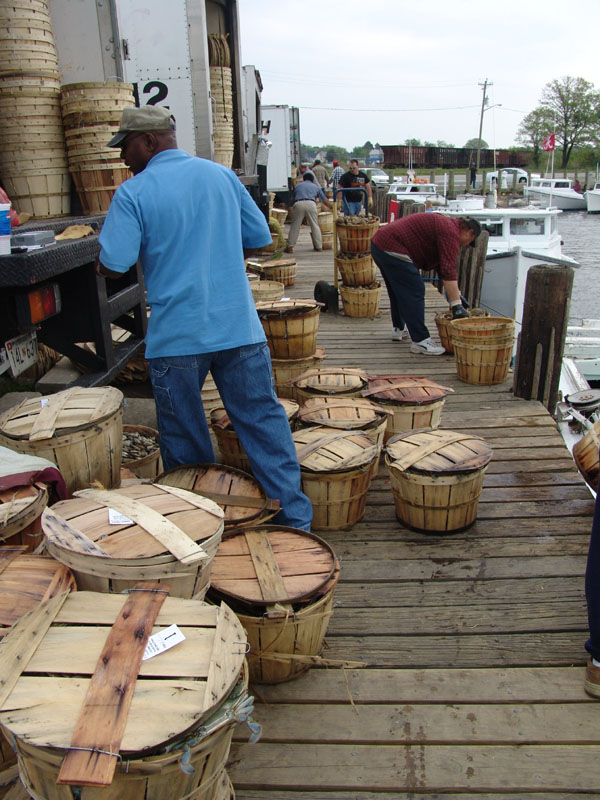
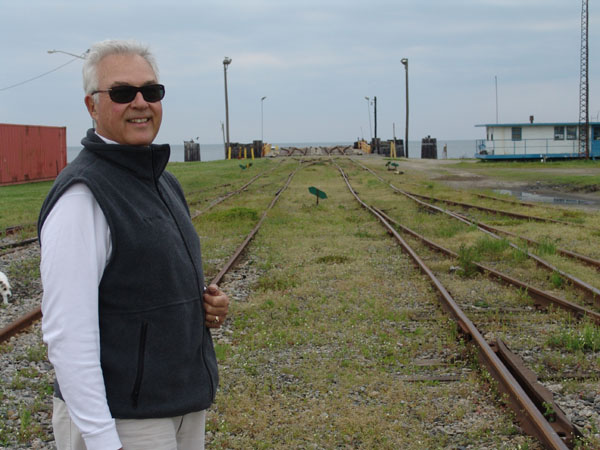 From the docks you can see the main street of Capes Charles
and the historic old brick store fronts. We also, could watch the activity or
the rail yard. We were the only pleasure boaters there. Itís early yet but we
doubt if too many boaters come here because they really arentí set up for
boaters like us. There is a new resort that has gone in nearby but the marina
is having problems with the dredging so a boat like ours would not even be able
to get in there. We walked a short walk to town across the wide stretch of
railroad tracks. As we were crossing the railroad tracks we were reminded that
this is the terminus for the railroad that linked New York to Norfolk area. It
also connected this end of the Eastern Shore peninsula to Norfolk area. Goods
were transported by train here and loaded onto barges and ferries which then
crossed the mouth of the Chesapeake to Norfolk. Ferries piled in and out of
here, transporting 2 million passengers a year. Thatís a lot of people coming
through this little town. After the great Bay Bridge and Tunnel was built, the
ferries virtually ceased and the railroad barge loading took a back street to
the tunnel mode of transportation. Doesnít mean it all came to a halt though as
we watched them load a barge with several loaded train cars. We watched the
waiting tug pull them out of the harbor at dusk heading for Norfolk.
From the docks you can see the main street of Capes Charles
and the historic old brick store fronts. We also, could watch the activity or
the rail yard. We were the only pleasure boaters there. Itís early yet but we
doubt if too many boaters come here because they really arentí set up for
boaters like us. There is a new resort that has gone in nearby but the marina
is having problems with the dredging so a boat like ours would not even be able
to get in there. We walked a short walk to town across the wide stretch of
railroad tracks. As we were crossing the railroad tracks we were reminded that
this is the terminus for the railroad that linked New York to Norfolk area. It
also connected this end of the Eastern Shore peninsula to Norfolk area. Goods
were transported by train here and loaded onto barges and ferries which then
crossed the mouth of the Chesapeake to Norfolk. Ferries piled in and out of
here, transporting 2 million passengers a year. Thatís a lot of people coming
through this little town. After the great Bay Bridge and Tunnel was built, the
ferries virtually ceased and the railroad barge loading took a back street to
the tunnel mode of transportation. Doesnít mean it all came to a halt though as
we watched them load a barge with several loaded train cars. We watched the
waiting tug pull them out of the harbor at dusk heading for Norfolk. 
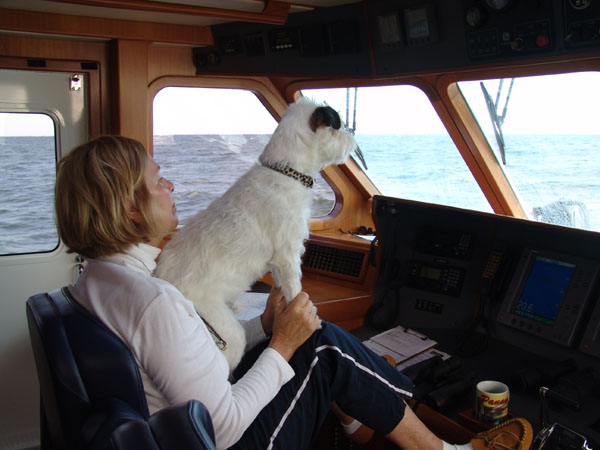 The seas settled themselves
down after a couple hours which made Ziggy happy and we continued to weave our
way through the crab pots. We arrived in Crisfield about 2:00 in the
afternoon. The docks were empty except for a few local boats. Itís cold and
overcast out. We get settled at the dock and explore the town. The museum is
closed and the boats are not running to Tangiers which was our main purpose for
coming here. We missed the opportunity of catching the ferry last year at
Onancock to Tangiers because the ferry captain was painting the boat the week we
came and now they donít start running until May 15th.
The seas settled themselves
down after a couple hours which made Ziggy happy and we continued to weave our
way through the crab pots. We arrived in Crisfield about 2:00 in the
afternoon. The docks were empty except for a few local boats. Itís cold and
overcast out. We get settled at the dock and explore the town. The museum is
closed and the boats are not running to Tangiers which was our main purpose for
coming here. We missed the opportunity of catching the ferry last year at
Onancock to Tangiers because the ferry captain was painting the boat the week we
came and now they donít start running until May 15th. 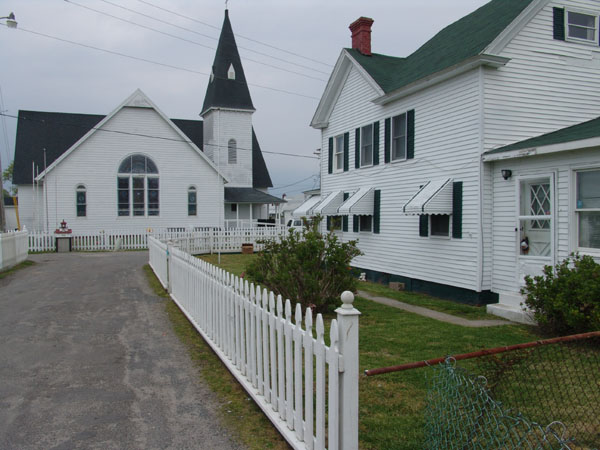
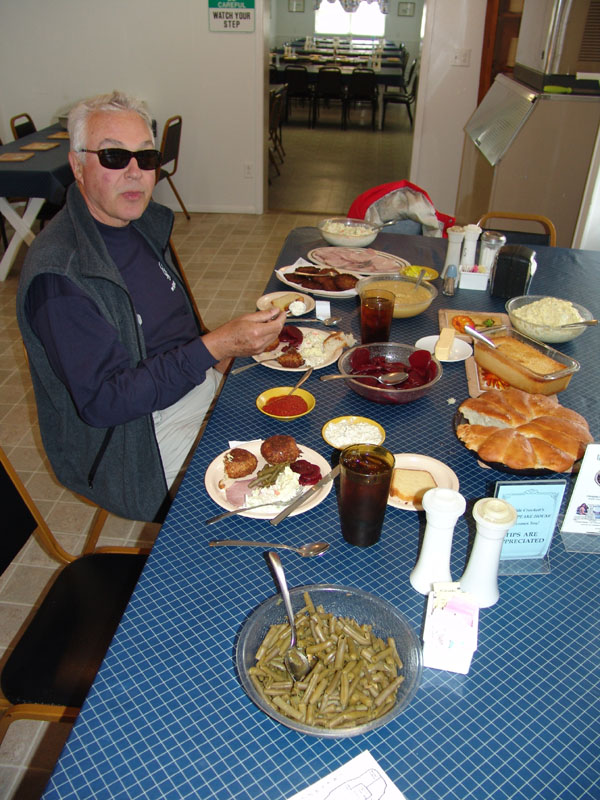 We knock on the door and ask if
we can have lunch. We explain that Ziggy is with us and she says we can tie him
up out front inside the white picket fence on the grass. She said heíd be fine
and we could watch him through the window. She said as soon as the lunch was
ready sheíd call us. In the meantime we could sit on the screened in porch
until it was ready. Zig seemed OK outside and whined and cried a little but
survived.
We knock on the door and ask if
we can have lunch. We explain that Ziggy is with us and she says we can tie him
up out front inside the white picket fence on the grass. She said heíd be fine
and we could watch him through the window. She said as soon as the lunch was
ready sheíd call us. In the meantime we could sit on the screened in porch
until it was ready. Zig seemed OK outside and whined and cried a little but
survived.